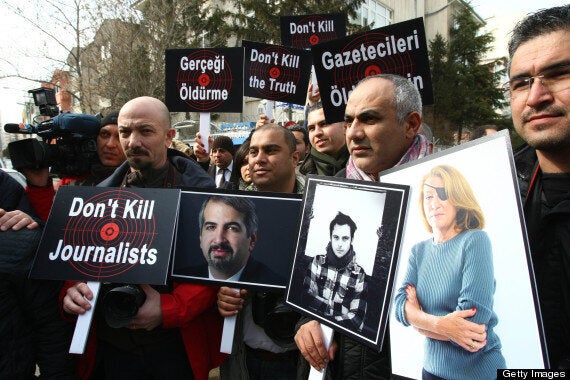Syria is the deadliest place for journalists, who are deliberately targeted by both the government and rebel groups, according to a new human rights report.
At least 36 journalists have been killed in targeted attacks since 2011, but opposition and government groups have also targeted online reporting, hacking sites and sent death threats.
Both professional and citizen journalists have been killed, kidnapped, tortured or have simply vanished, Amnesty International said in a report, Shooting the Messenger, launched to mark World Press Freedom Day.

Turkish journalists in Ankara hold pictures of journalists who died covering the crisis in Syria
In February 2012, Sunday Times reporter Marie Colvin, and French photographer Rémi Ochlik were killed in a deliberate attack on the media centre in Homs, which was shelled by government forces.
Emilie Blachere, girlfriend of photographer Ochlik, is still fighting for justice for her partner, taking part in the official campaign 'The Day Without News' earlier this year, which paid tribute to journalists risking their lives to document conflict.
"Rémi died in Syria doing his job, and because he was doing his job, he was targeted, and still, nobody has been accused or arrested. The murder of journalists and photographers carries on with impunity," she said.
"We want reporters to go everywhere, and especially we need them to come back safe and sound to continue their work.”
Now, barely any news organisation has a correspondent in Syria covering the conflict, with the Sunday Times announcing they will not accept any freelance photographs taken in Syria which might encourage young snappers to risk their lives in the country.

Remi Ochlik, who was killed in Syria along with Marie Colvin
AFP, one of the few news agencies who still has reporters in the country, has enforced strict guidelines.
Reporters must have volunteered to go, have taken hostile environment training courses, carry a bullet proof vest, helmet, protective suit and first aid kit and local "stringers" who wish to work for AFP must meet minimum safety pre-conditions when they pitch, or the story will not be run.
Bloody civil war still rages in Syria, where an estimated 70,000 people have died in two years, with 1.3m refugees fleeing across borders to Lebanon and Jordan.
Other journalists targeted include Ali Mahmoud Othman, a citizen journalist from Homs who was arrested by government security forces in March last year. Othman was part of a network of media activists which ran the “Homs Media Centre” during the Syrian army’s siege of the Baba ‘Amr district of the city in February 2012.
He facilitated the movement of foreign journalists in and out of Homs, including British journalist Paul Conroy and French reporter Edith Bouvier after they were injured in shelling.
Conroy said of Othman: “He was one of the activists who just made things happen at the media centre. He would take journalists to the front line or to field hospitals, or anywhere where they would be able to get a good camera shot.”
No-one has heard from Othman since he appeared a state television in April last year, though his family has reportedly received word from an unofficial source that at one stage he had been transferred to the infamous Saydnaya Military Prison near Damascus.
In another case featured in the report, state television presenter Mohamad al-Sa’eed was abducted from his home in Damascus in July 2012 and summarily killed by Jabhat al-Nusra, an Islamist armed opposition group. In a statement published on their website on 3 August, Jabhat al-Nusra said they had “abducted the media shabih Mohamad al-Sa’eed on 19 July 2012, and killed him after he was interrogated”.

James Foley, a video journalist for AFP who is missing in the country
Several foreign journalists have gone missing in Syria, with no confirmed information about where they are held, who captured them, or their fate. American freelance reporter James Foley, 39, who was working for AFP and Global Post, was abducted in north-western Syria, in November 2012 on his way to the Turkish border to leave Syria when he was stopped by unknown armed men in an unmarked car. No official statement has been provided by any armed opposition group regarding the abduction of James Foley.
Another American freelancer, Austin Tice, 31, has been missing since mid-August 2012, up until which time he had been writing regularly for the Washington Post and Al Jazeera English, but most frequently for McClatchy newspapers, where he won a Polk Award.
Tice was repotedly near Damascus when he went missing in unclear circumstances. In late August, Czech Embassy officials in Syria, who oversee US interests in Syria, said that they believed he was in the custody of Syrian forces, and the next month, a YouTube video appeared to show him in the custody of unidentified armed individuals, circulated on a pro-government social networkimg site.
Amnesty International Middle East and North Africa Deputy Director Ann Harrison said: “Deliberate attacks on civilians, including journalists, amount to war crimes for which the perpetrators must be brought to justice. We have once again documented how all sides in this conflict are violating the laws of war, although the scale of abuse by government forces remains much greater.
“We have been calling for over two years for the international community to take meaningful steps to ensure those responsible from all sides are held to account for international crimes and other abuses and for victims to receive reparations, but the Syrian people are still waiting.
“How much more evidence of war crimes and crimes against humanity does the UN Security Council need to see before it refers the situation in Syria to the prosecutor of the International Criminal Court?”
Abu 'Obaidah al-Idlibi’, 20, a citizen journalist from al-Dana, Idlib province was arrested in May 2012 and held at the Central Prison for a week after he was caught photographing security forces on the street
I was beaten at the start, but I had heard that the punishment for people who make videos is eye-gouging so I denied being a citizen journalist. They repeatedly asked me why I was taking the photographs and with whom I worked.
"They also threw other accusations at me, such as, ‘Where are the weapons you had?’ I kept on telling them that I was not armed. Thankfully I did not have any saved videos on the phone I was carrying, only pictures of Bashar al-Assad and some nationalist songs that I had put on my phone in case I was stopped at a checkpoint. When they searched my phone and saw these pictures they became much less suspicious.
Following my release, I wrote online criticizing the behaviour of shabiha militias in Idlib. Soon after, he said, he was attacked in his office by a group of armed men.
“I was in my office in June 2012 when it happened, men in civilian clothing barged in with their faces covered. They held me at gunpoint with their weapons in my face and stole all my equipment.
"They did not say much beyond talking about the report I had published about them. They left me in the office with the threat: ‘Let’s see if you take another photo’.”